Hampton Court Palace
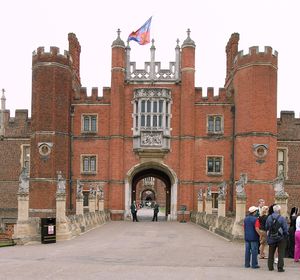
Hampton Court Palace is a royal palace in the London Borough of Richmond upon Thames in south west London; it has not been lived in by the British royal family since the 18th century. The palace is located 11.7 miles (18.8 km) south west of Charing Cross and upstream of Central London on the River Thames. It was originally built for Cardinal Wolsey, a favourite of King Henry VIII, circa 1514; in 1529, as Wolsey fell from favour, the palace was passed to the King, who enlarged it.
The following century, William III's massive rebuilding and expansion project intended to rival Versailles was begun.[1] Work halted in 1694, leaving the palace in two distinct contrasting architectural styles, domestic Tudor and Baroque. While the palace's styles are an accident of fate, a unity exists due to the use of pink bricks and a symmetrical, albeit vague, balancing of successive low wings.[2]
Today, the palace is open to the public, and is a major tourist attraction. It is cared for by an independent charity, Historic Royal Palaces which receives no funding from the Government or the Crown.[3]
The palace's Home Park is the site of the annual Hampton Court Palace Festival and Hampton Court Palace Flower Show. Along with St. James's Palace, it is one of only two surviving palaces out of the many owned by Henry VIII.
Contents |
History
Tudor period

Thomas Wolsey, Archbishop of York, Chief Minister and favourite of King Henry VIII, took over the site of Hampton Court Palace in 1514.[4] It had previously been a property of the Order of St John of Jerusalem.[2] Over the following seven years, Wolsey spent lavishly to build the finest palace in England at Hampton Court, a figure of 200,000 gold crowns.[5] Wolsey rebuilt the existing manor house to form the nucleus of the present palace. Today, little of Wolsey's building work remains unchanged. The first courtyard, the Base Court,[6] (B on plan), was his creation, as was the second, inner gatehouse (C) which leads to the Clock Court (D) (Wolsey's seal remains visible over the entrance arch of the clock tower[7]) which contained his private rooms (O on plan).[4] The Base Court contained forty-four lodgings reserved for guests, while the second court (today, Clock Court) contained the very best rooms—the state apartments—reserved for the King and his family.[8] Henry VIII stayed in the state apartments as Wolsey's guest immediately after their completion in 1525.
In building his palace, Wolsey was attempting to create a Renaissance cardinal's palace featuring rectilinear symmetrical planning with grand apartments on a raised piano nobile, all rendered with classical detailing. Jonathan Foyle has suggested[9] that it is likely that Wolsey had been inspired by Paolo Cortese's De Cardinalatu, a manual for cardinals that included advice on palatial architecture, published in 1510. The architectural historian Sir John Summerson asserts that the palace shows "the essence of Wolsey—the plain English churchman who nevertheless made his sovereign the arbiter of Europe and who built and furnished Hampton Court to show foreign embassies that Henry VIII's chief minister knew how to live as graciously as any cardinal in Rome."[10] Whatever the concepts were, the architecture is an excellent and rare example of a thirty-year era when English architecture was in a harmonious transition from domestic Tudor, strongly influenced by perpendicular Gothic, to the Italian Renaissance classical style. Perpendicular Gothic owed nothing historically to the Renaissance style, yet harmonised well with it.[11] This blending of styles was realised by a small group of Italian craftsmen working at the English court in the second and third decades of the sixteenth century. They specialised in the adding of Renaissance ornament to otherwise straightforward Tudor buildings.[11] It was one of these, Giovanni da Maiano who was responsible for the set of eight relief busts of Roman emperors which were set in the Tudor brickwork.[12]
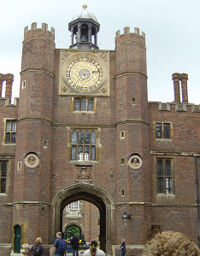
Wolsey was only to enjoy his palace for a few years.[10] In 1528, knowing that his enemies and the King were engineering his downfall, he passed the palace to the King as a gift. Wolsey died the following year.[10]
Within six months of coming into ownership, the King began his own rebuilding and expansion.[8] Henry VIII's court consisted of over one thousand people, while the King owned over sixty houses and palaces. Few of these were large enough to hold the assembled court, and thus one of the first of the King's building works (in order to transform Hampton Court to a principal residence) was to build the vast kitchens. These were quadrupled in size in 1529.[13]. The architecture of King Henry's new palace followed the design precedent set by Wolsey: perpendicular Gothic-inspired Tudor with restrained Renaissance ornament. This hybrid architecture was to remain almost unchanged for nearly a century, until Inigo Jones introduced strong classical influences from Italy to the London palaces of the first Stuart kings.
Between 1532 and 1535 Henry added the Great Hall (the last medieval great hall built for the English monarchy) and the Royal Tennis Court.[14] The Great Hall features a carved hammer-beam roof. During Tudor times, this was the most important room of the palace; here, the King would dine in state seated at a table upon a raised dais.[15] The hall took five years to complete, so impatient was the King for completion that the masons were compelled to work throughout the night by candlelight.[16]
The gatehouse to the second, inner court was adorned in 1540 with an early example of a post-Copernican astronomical clock. Still functioning, the clock shows the time of day, the phases of the moon, the month, the quarter of the year, the date, the sun and star sign, and high water at London Bridge.[17] The latter information was of great importance to those visiting this Thames-side palace from London, as the preferred method of transport at the time was by barge, and at low water London Bridge created dangerous rapids. This gatehouse is also known today as Anne Boleyn's gate, after Henry's second wife. Work was still underway on Anne Boleyn's apartments above the gate when the King, having tired of her, had her executed.[18]
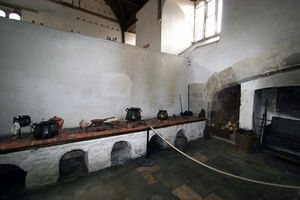
During the Tudor period, the palace was the scene of many historic events. In 1537, the King's much desired male heir, the future Edward VI, was born at the palace and the child's mother, Jane Seymour, died there two weeks later.[19] Four years afterwards, whilst attending Mass in the palace's chapel, the King was informed of his fifth wife's adultery. The Queen, Catherine Howard, was dragged away, screaming, from a gallery leading to the chapel. Her ghost is said to haunt it.[20]
King Henry died in January 1547 and was succeeded first by his son Edward VI, and then by both his daughters in turn. It was to Hampton Court that Queen Mary I (Henry's eldest daughter) retreated with King Philip II of Spain to spend her honeymoon, after their wedding at Winchester.[16] The marriage, politically expedient rather than a love match, proved childless, and Mary was succeeded by her half-sister, Elizabeth I. It was Elizabeth who had the Eastern kitchen built; today, this is the palace's public tea room.[21]
Hampton Court Palace has had a street in the Roman town of Towcester or Lactodorum named after it.
Stuart period

On the death of Elizabeth I in 1603, the Tudor period came to an end. The Queen was succeeded by her first cousin-twice-removed, the Scottish King, James VI, who became known in England as James I of the House of Stuart.
In 1604, the palace was the site of King James' meeting with representatives of the English Puritans, known as the Hampton Court Conference; while agreement with the Puritans was not reached, the meeting led to James's commissioning of the King James Version of the Bible.[22]
King James was succeeded in 1625 by his son, the ill-fated Charles I. For this king, Hampton Court was to become both his palace and his prison.[22] It was also the setting for his honeymoon with his fifteen year old bride, Henrietta Maria in 1625.[16] Following King Charles' execution in 1649, the palace became the property of the Commonwealth presided over by Oliver Cromwell. Unlike some other former royal properties, the palace escaped relatively unscathed. While the government auctioned much of the contents, the building was ignored.[23]
After the Restoration, King Charles II and his successor James II, visited Hampton Court, but largely preferred to reside elsewhere. By this time, by current French court standards Hampton Court appeared old-fashioned. It was in 1689, shortly after Louis XIV's court had moved permanently to Versailles, that the palace's antiquated state was addressed. England had two new joint monarchs, William of Orange and his wife, the daughter of James II, Queen Mary II. Within months of their accession they embarked on a massive rebuilding project at Hampton Court. The intention was to demolish the Tudor palace a section at a time, while replacing it with a huge modern palace in the Baroque style retaining only Henry VIII's Great Hall.[24] The country's most eminent architect, Sir Christopher Wren, was called upon to draw the plans, while the master of works was to be William Talman. The plan was for a vast palace constructed around two courtyards at right angles to each other. Wren's design for a domed palace bore resemblances to the work of Jules Hardouin Mansart and Louis Le Vau, both architects employed by Louis XIV at Versailles.[24] It has been suggested, though, that the plans were abandoned because the resemblance to Versailles was too subtle and not strong enough; at this time, it was impossible for any sovereign to visualise a palace that did not emulate Versailles' repetitive Baroque form.[25] However, the resemblances are there: while the facades are not so long as those of Versailles, they have similar seemingly unstoppable repetitive rhythms beneath a long flat skyline. The monotony is even repeated as the facade turns the corner from the east to the south fronts. However, Hampton Court, unlike Versailles, is given an extra dimension by the contrast between the pink brick and the pale Portland stone quoins, frames and banding.[26] Further diversion is added by the circular and decorated windows of the second floor mezzanine. This theme is repeated in the inner Fountain Court, but the rhythm is faster and the windows, unpedimented on the outer facades, are given pointed pediments in the courtyard; this has led the courtyard to be described as "Startling, as of simultaneous exposure to a great many eyes with raised eyebrows."[27]
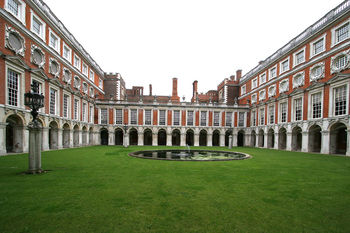
During this work, half the Tudor palace was replaced and Henry VIII's state rooms were lost; the new wings around the Fountain Court contained new state apartments and private rooms, one set for the King and one for the Queen. Each suite of state rooms was accessed by a state staircase. The royal suites were of completely equal value in order to reflect William and Mary's unique status as joint sovereigns.[28] The King's Apartments face south over the Privy Garden, the Queen's east over the Fountain Garden. The suites are linked by a gallery running the length of the east facade, another reference to Versailles, where the King and Queen's apartments are linked by the Galerie des Glaces. However, at Hampton Court the linking gallery is of more modest proportions and decoration. The King's staircase was decorated with frescos by Antonio Verrio and delicate ironwork by Jean Tijou.[29] Other artists commissioned to decorate the rooms included Grinling Gibbons, Sir James Thornhill and Jacques Rousseau; furnishings were designed by Daniel Marot.[30]
After the death of Queen Mary, King William lost interest in the renovations, and work ceased. However, it was in Hampton Court Park in 1702 that he fell from his horse, later dying from his injuries at Kensington Palace. He was succeeded by his sister-in-law Queen Anne who continued the decoration and completion of the state apartments. On Queen Anne's death in 1714 the Stuart dynasty came to an end.
Queen Annes's successor was George I; he and his son George II were the last monarchs to reside at Hampton Court.[1] Under George I six rooms were completed in 1717 to the design of John Vanbrugh.[31] Under George II and his Queen, Caroline, further refurbishment took place, with the architect William Kent employed to design new furnishings and decor including the Queen's Staircase, (1733)[32] and the Cumberland Suite (1737) for the Duke of Cumberland.[32] Today, the Queen's Private Apartments are open to the public and include her bathroom and bedroom.
Contents

The palace houses many works of art and furnishings from the Royal Collection, mainly dating from the two principal periods of the palace's construction, the early Tudor (Renaissance) and late Stuart to Early Georgian period. The single most important works are Mantegna's Triumphs of Caesar housed in the Lower Orangery. The palace once housed the Raphael Cartoons now kept at the Victoria and Albert Museum. Their former home, the Cartoon Gallery on the south side of the Fountain Court, was designed by Christopher Wren; copies painted in the 1690s by a minor artist, Henry Cooke, are now displayed in their place. Also on display are important collections of ceramics, including numerous pieces of blue and white porcelain collected by Queen Mary II, both Chinese imports and Delftware.
 Mantegna's Triumph of Ceaser, 1st part |
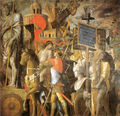 Mantegna's Triumph of Ceaser, 2nd part |
 Mantegna's Triumph of Ceaser, 3rd part |
 Mantegna's Triumph of Ceaser, 4th part |
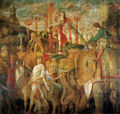 Mantegna's Triumph of Ceaser, 5th part |
 Mantegna's Triumph of Ceaser, 6th part |
 Mantegna's Triumph of Ceaser, 7th part |
 Mantegna's Triumph of Ceaser, 8th part |
|
Mantegna's Triumph of Ceaser, part 9 Julius Caesar on his triumphal chariot |

Much of the original furniture from the late 17th and early 18th centuries, including tables by Jean Pelletier, "India back" walnut chairs by Thomas Roberts and clocks and a barometer by Thomas Tompion. Several state beds are still in their original positions, as is the Throne Canopy in the King's Privy Chamber. This room contains a crystal chandelier of circa 1700, possibly the first such in the country.[33]
The King's Guard Chamber contains a large quantity of arms: muskets, pistols, swords, daggers, powderhorns and pieces of armour arranged on the walls in decorative patterns. Bills exist for payment to a John Harris dated 1699 for the arrangement, which is believed to be that which can still be seen today.
Chapel
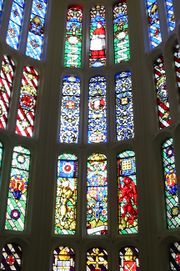
The double height chapel was begun by Wolsey and completed under Henry VIII. Its timber and plaster ceiling, a Gothic vault with Renaissance pendants completed by trumpeting boys, is considered the "most important and magnificent in Britain."[20] The altar is framed by a massive oak reredos in Baroque style carved by Grinling Gibbons during the reign of Queen Anne.[20] Opposite the altar, at first floor level, is the royal pew where the royal family would attend services apart from the general congregation seated below. Queen Catherine Howard was painfully dragged down this gallery pleading to Henry not to be executed.
Grounds
The grounds as they appear today were laid out in grand style in the late 17th century. There are no authentic remains of Henry VIII's gardens, merely a small knot garden, planted in 1924 which hints at the gardens' 16th century appearance.[34] Today, the dominating feature of the grounds is the great landscaping scheme constructed for Sir Christopher Wren's intended new palace. From a water-bounded semicircular parterre, the length of the east front, three avenues radiate in crow's foot pattern. The central avenue containing not a walk or a drive, but the great canal, known as the Long Water, excavated during the reign of Charles II, in 1662. The design, radical at the time, is another immediately recognizable influence from Versailles, and was indeed laid out by pupils of André Le Nôtre, Louis XIV's landscape gardener.[26]
On the south side of the palace is the Privy Garden bounded by semi-circular wrought iron gates by Jean Tijou.[35] This garden, originally William III's private garden, was replanted in 1992 with manicured hollies and yews along a geometric system of paths.[34]
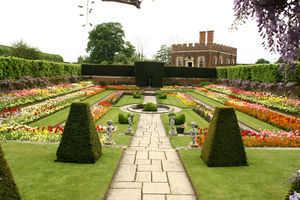
On a raised site overlooking the Thames, is a small pavilion, the Banqueting House. This was built circa 1700, for pleasurable and informal picnics and entertainments in the gardens rather than for the larger state dinners which would have taken place inside the palace itself. A nearby conservatory houses the "Great Vine", planted in 1769; by 1968 it had a trunk 81 inches thick and has a length of 100 feet.[26] It still produces an annual crop of grapes.[36]
A well known curiosity of the palace's grounds is Hampton Court Maze; planted in the 1690s by George London and Henry Wise for William III of Orange.[36] The maze covers a third of an acre and contains half a mile of paths. It is possible that the current design replaced an earlier maze planted for Cardinal Wolsey. It was originally planted with hornbeam; it has been repaired latterly using many different types of hedge.
Inspired by a painting, The Family of Henry VIII, hanging in the palace's Haunted Gallery, a new garden in the style of Henry VIII’s 16th century Privy Gardens has been designed to celebrate the anniversary of that King’s accession to the throne. Sited on the former Chapel Court Garden, it has been planted with flowers and herbs from the 16th century, and is complete by gilded heraldic beasts and bold green and white painted fences. The heraldic beasts carved by Ben Harms and Ray Gonzalez of G&H Studios includes The Golden Lion of England, The White Greyhound of Richmond, The Red Dragon of Wales and the White Hart of Richard II, are all carved from English oak. The garden's architect was Todd Langstaffe-Gowan, who collaborated with James Fox and the Gardens Team at Historic Royal Palaces.
Latter years
After the reign of George II, no monarch ever resided at Hampton Court. In fact, George III, from the moment of his accession, never set foot in the palace; he associated the state apartments with a humiliating scene when his father had once struck him following an innocent remark.[37]
In 1796, the Great Hall was restored and in 1838, Queen Victoria completed the restoration and opened the palace to the public. The heavy-handed restoration plan at this time, reduced the Great Gatehouse (A), the palace's principal entrance, by two stories and removed the lead cupolas adorning its four towers.[38]
On 2 September 1952, the palace was given statutory protection by being grade I listed.[39] Other buildings and structures within the grounds are separately grade I listed, including the early 16th-century tilt yard tower — the only surviving example of the five original towers;[40] Christopher Wren's Lion gate built for Queen Anne and George I;[41] and the Tudor and 17th-century perimeter walls.[42]
Throughout the 20th century in addition to becoming a major London tourist attraction, the palace housed 50 grace and favour residences given to esteemed servants and subjects of the crown. It was an elderly recipient of one such grace and favour apartment who caused a major fire, which spread to the King's Apartments in 1986. This led to a new programme of restoration work which was completed in 1990.
See also
- Treaty of Hampton Court (1562), also known as the Treaty of Richmond, signed on 22 September 1562 between Queen Elizabeth and Huguenot leader Louis I de Bourbon, prince de Condé.
- Hampton Court Park
- Het Loo
- List of artists at Hampton Court Palace
- Hampton Court Maze
- Royal Tennis Court, Hampton Court
- Ben Harms
Notes
- ↑ 1.0 1.1 Dynes, P90.
- ↑ 2.0 2.1 Dynes, P86
- ↑ http://www.hrp.org.uk/aboutus/whoweare/default.aspx
- ↑ 4.0 4.1 Summerson, P12.
- ↑ Williams, P52.
- ↑ "Base" in this instance simply means "lower" in the hierarchy of courtyards; it is not topographically lower.
- ↑ Spelthorne Hundred: Hampton Court Palace: architectural description, A History of the County of Middlesex, Volume 2: General; Ashford, East Bedfont with Hatton, Feltham, Hampton with Hampton Wick, Hanworth, Laleham, Littleton (1911), pp. 371-379. accessed: 21 March 2009
- ↑ 8.0 8.1 Thurley, P6.
- ↑ Jonathan Foyle: "Hampton Court: the lost Palace" 2002
- ↑ 10.0 10.1 10.2 Summerson, P14.
- ↑ 11.0 11.1 Copplestone, P254.
- ↑ Copplestone, P257.
- ↑ Thurley, P8.
- ↑ This court is still in use for the game of real tennis, an older version different from the present game. It is now the oldest extant Real Tennis Court.
- ↑ Summerson, P21.
- ↑ 16.0 16.1 16.2 Williams, P52
- ↑ Thurley, P18
- ↑ Williams, P53
- ↑ Thurley, p9.
- ↑ 20.0 20.1 20.2 Thurley, P23.
- ↑ Thurley, P9.
- ↑ 22.0 22.1 Thurley, P10.
- ↑ Thurley, P11.
- ↑ 24.0 24.1 Summerson, P16.
- ↑ This is the stated opinion of Sir John Summerson. Summerson, P19.
- ↑ 26.0 26.1 26.2 Dynes, P95.
- ↑ 27.0 27.1 Summerson, P19.
- ↑ Williams, P54.
- ↑ Dynes, P94.
- ↑ The furnishing was discussed by Tessa Murdoch, "The furniture for the King's Apartments: 'Walnuttree' gilding, japanning and marble", Apollo 140 (August 1994) pp 55-60.
- ↑ Thurley, Simon. Hampton Court: A Social and Architectural History. 2003. p. 255
- ↑ 32.0 32.1 Thurley, Simon. Hampton Court: A Social and Architectural History. 2003. p. 279.
- ↑ Mortimer, Martin. The English Glass Chandelier. 2000. p. 41.
- ↑ 34.0 34.1 Thurley, P44.
- ↑ Dynes. P95.
- ↑ 36.0 36.1 Thurley, P46.
- ↑ Williams, P54
- ↑ Dynes, P91.
- ↑ Images of England — details from listed building database (205384) accessed 27 March 2009
- ↑ Images of England — details from listed building database (205392) accessed 27 March 2009
- ↑ Images of England — details from listed building database (205395) accessed 27 March 2009
- ↑ Images of England — details from listed building database (205385) accessed 27 March 2009
References
- Dynes, Wayne (1968). Palaces of Europe. London: Hamlyn. OCLC 37658.
- Copplestone, Trewin (1963). World Architecture. London: Hamlyn.
- Summerson, John (1969). Great Palaces (Hampton Court. Pages 12–23). London: Hamlyn Publishing Group Ltd. ISBN 0600 01682 X.
- Thurley, Simon (1996). Hampton Court Palace. London: Historic Royal Palaces.
- Williams, Neville (1971). Royal Homes. Lutterworth Press. ISBN 0-7188-0803-7.
External links
- Official site at Historic Royal Palaces
- Historic photos of Hampton Court Palace
- Hampton Court by Walter Jerrold
- Grace & Favour: A handbook of who lived where at Hampton Court 1750-1950 - there are full floor plans of the palace on pages 10–13
- Jonathan Foyle: "Hampton Court: the lost Palace" 2002
- Aerial view of the maze at Google Maps
- The Hampton Court Flower Show
- The Royal Tennis Court at Hampton Court Palace
- The Choir of The Chapel Royal at Hampton Court Palace
- Aerial photo and map
- Areal photo and solution map to the Maze
|
||||||||||
|
||||||||||||||||||||


